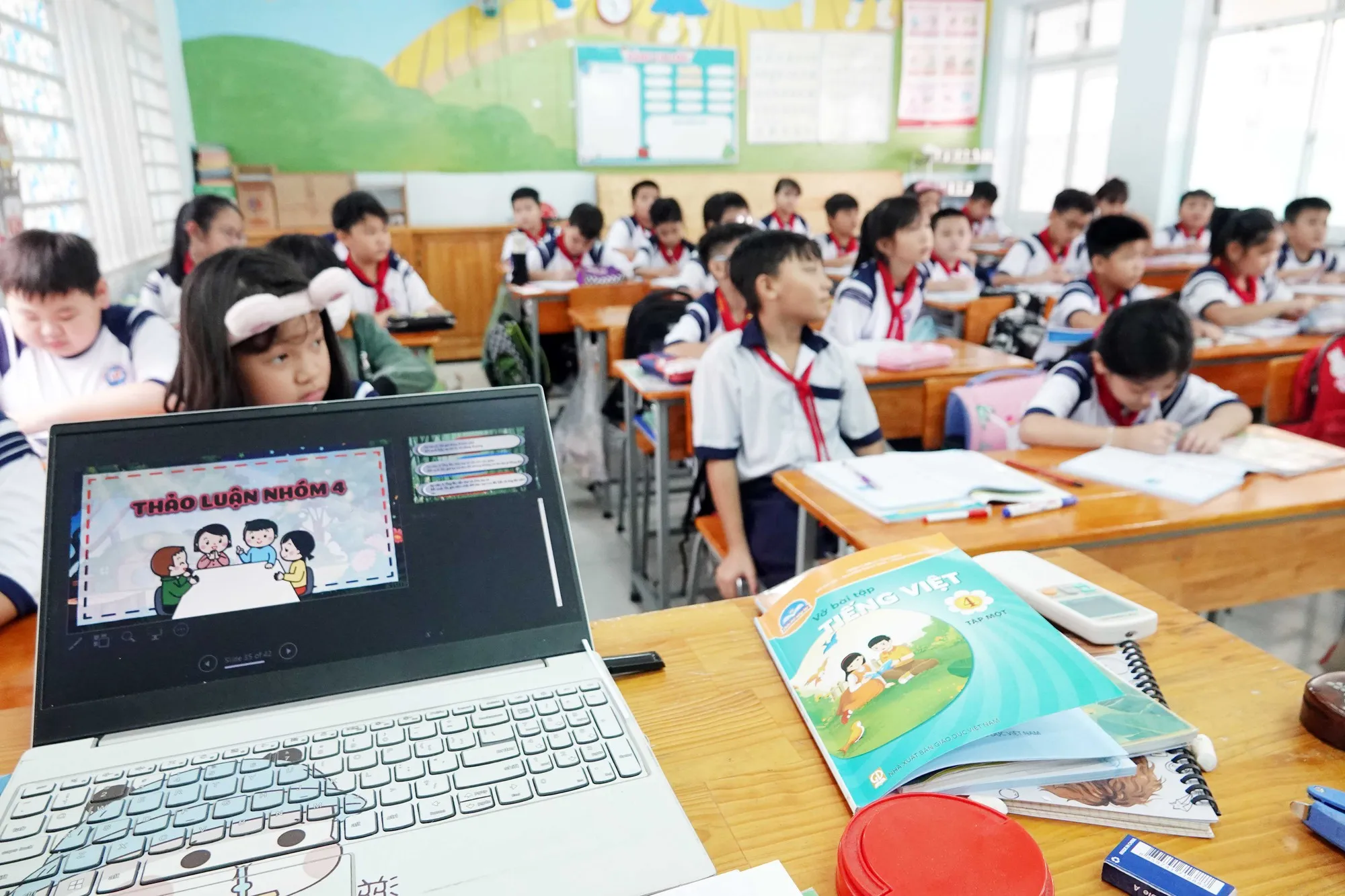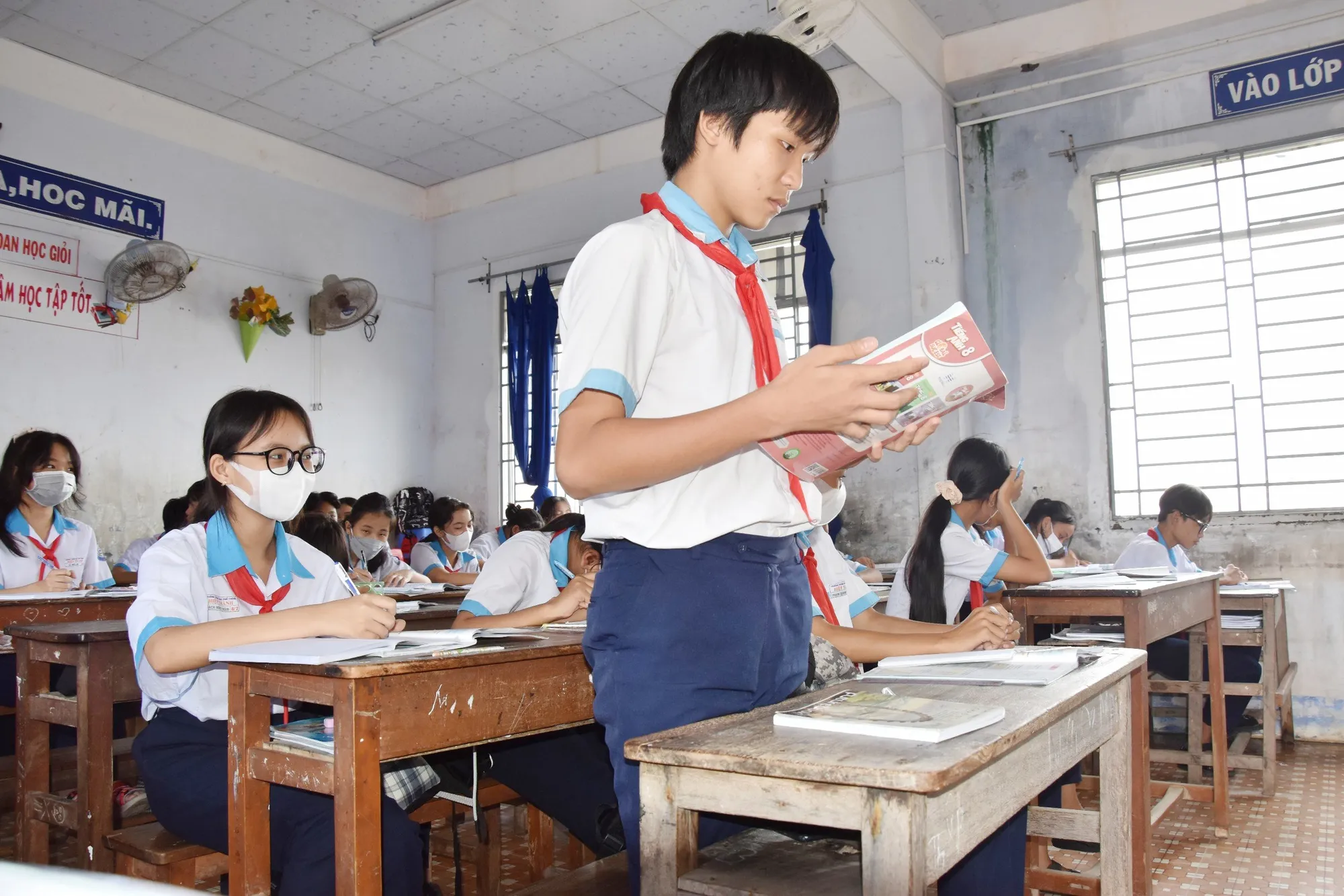Parliamentary oversight also pointed out many shortcomings.
Currently, the standards for student desks and chairs in primary, secondary, and high schools nationwide are applied according to Joint Circular No. 26/2011/TTLT-BGD&ĐT-BKHCN-BYT (Circular 26) issued by the Ministry of Education and Training, the Ministry of Science and Technology, and the Ministry of Health on June 16, 2011, guiding the standards for student desks and chairs in primary, secondary, and high schools.
This circular stipulates that student desks and chairs are divided into 6 sizes for students with heights ranging from 100 cm to 175 cm. Each size specifies the basic dimensions of the desks and chairs, and how to arrange them in the classroom to ensure suitability for the majority of students with normal anthropometric measurements.
However, a recent monitoring report by the National Assembly Standing Committee on curriculum and textbook reform also pointed out that Circular 26 has shortcomings. Specifically, Circular 26 stipulates desk and chair sizes in six numerical categories, but does not specify desk and chair sizes for students taller than 175 cm. "However, these standards were developed based on survey data on physical development and anthropometrics of students from 2001-2004. After nearly 20 years, the physical condition of students has changed significantly," the report stated.

Many schools in Ho Chi Minh City are equipped with desks and chairs designed to accommodate a maximum of two students.
According to the report, surveys conducted in some localities revealed that they did not survey the average height of students before purchasing school supplies, instead purchasing all the same size and assigning students to the same classroom from the beginning to the end of the school year. Therefore, the monitoring team requested the Ministry of Education and Training to coordinate with the Ministry of Health and the Ministry of Science and Technology to revise Circular 26 to better suit the current development and stature of students.
What does the Ministry of Education and Training say?
Speaking to a reporter from Thanh Nien newspaper, Mr. Pham Hung Anh, Director of the Department of Facilities (Ministry of Education and Training), said: "Through field surveys and feedback from the grassroots, currently in some localities with developed economies and well-cared-for children, some high school students have heights exceeding 175 cm, leading to the desks and chairs not being suitable according to regulations."
According to Mr. Hung Anh, in the coming time, the Ministry of Education and Training will coordinate with the Ministry of Science and Technology, the Ministry of Health, and the Vietnam Institute of Educational Sciences to research student anthropometry. Based on the research results, the Ministry of Education and Training will adjust and amend Circular 26 to suit the actual physical condition of students. While waiting for the circular to be amended, if schools and localities purchase new desks and chairs, they need to flexibly survey and assess the actual physical condition of students to choose the appropriate size and number of desks and chairs.
Approximately 63% of schools use two-seater desks and chairs.
According to statistics from the Ministry of Education and Training, by the end of the last school year, the number of two-seater desks and chairs in schools nationwide reached approximately 63% (65% at the primary level, 65% at the lower secondary level, and 60% at the upper secondary level). Regulations stipulate that desks and chairs should not have more than two seats; however, in some remote and disadvantaged areas, old-style four-seater desks and chairs are still used, which are unsuitable for the learning model. "However, this number has improved significantly compared to 10 years ago when only about 40% of desks and chairs met the standards. This shows that localities are also very concerned about equipping students with desks and chairs that meet the standards," said Mr. Pham Hung Anh.
Circular 26, guiding the standards for student desks and chairs in primary, secondary, and high schools, stipulates: Desks and chairs should be designed for a maximum of two seats; desks and chairs must be separate and independent; desks must have a suitable storage space for learning materials. Chairs may or may not have backrests, depending on the age of the students. The corners and edges of the desks and chairs must be smooth to ensure aesthetics and safety. The colors used for desks and chairs must be aesthetically pleasing and appropriate for the learning environment of the students.
Mr. Hung Anh stated that Circular 26 currently only has one point that needs correction: it lacks size specifications for students with a height of 175 cm or more. Aside from this point, the current shortcomings regarding student desks and chairs are not due to the regulations of Circular 26, but rather to the implementation in various localities. When the Ministry inspected the physical infrastructure of localities, it was found that many localities were complying well with the regulations of Circular 26, but there were obstacles and constraints that needed to be addressed.
For example, Circular 26 has stipulated very specific and detailed sizes and codes for desks and chairs according to students' height groups, but many schools still arrange for students from the first to the last grade to sit in the same classroom with the same size of desks and chairs. This situation occurs most frequently at the primary school level because in urban areas, many parents, when their children enter first grade, often organize the purchase of air conditioners and wall-mounted equipment for their children's classrooms themselves, and want to agree with the school to have their children study in that room from grade 1 to grade 5. This results in the size of desks and chairs arranged in the first-grade classroom no longer being suitable for students in higher grades…

Many schools still use student desks and chairs that do not meet standards, with heights unsuitable for the physical stature of today's students.
Regarding this issue, the Director of the Department of Facilities stated that the Ministry has repeatedly instructed and requested localities to pay attention to arranging desks and chairs of the correct size according to regulations, ensuring that students do not have to sit on the same set of desks and chairs from the first to the last grade because their physical condition changes each year. Not only are desk and chair sizes adjusted for each grade, but the Ministry's regulations also clearly state: "Desks and chairs should be arranged to suit the majority of students. A classroom can have multiple sizes of desks and chairs simultaneously, not just one size for all students."
Responding to a question about whether schools have the right to independently purchase desks and chairs for their students to ensure the best fit for their needs and physical condition, Mr. Hung Anh stated that this depends on the procurement mechanism for teaching equipment in each locality. Some places have centralized procurement carried out by the provincial-level public procurement center; others delegate procurement to the district level based on the needs and proposals of schools within their jurisdiction…
Mr. Pham Hung Anh also stated that, although the Ministry's regulations stipulate that desks and chairs should be designed with a maximum of two seats, ideally, students should be provided with single chairs to allow for individualization and flexibility in arranging educational activities in the classroom.
Source link


![[Photo] Prime Minister Pham Minh Chinh receives Lao Minister of Education and Sports Thongsalith Mangnormek](/_next/image?url=https%3A%2F%2Fvphoto.vietnam.vn%2Fthumb%2F1200x675%2Fvietnam%2Fresource%2FIMAGE%2F2025%2F12%2F16%2F1765876834721_dsc-7519-jpg.webp&w=3840&q=75)
![[Photo] Prime Minister Pham Minh Chinh receives the Governor of Tochigi Province (Japan)](/_next/image?url=https%3A%2F%2Fvphoto.vietnam.vn%2Fthumb%2F1200x675%2Fvietnam%2Fresource%2FIMAGE%2F2025%2F12%2F16%2F1765892133176_dsc-8082-6425-jpg.webp&w=3840&q=75)
![[Live] 2025 Community Action Awards Gala](/_next/image?url=https%3A%2F%2Fvphoto.vietnam.vn%2Fthumb%2F1200x675%2Fvietnam%2Fresource%2FIMAGE%2F2025%2F12%2F16%2F1765899631650_ndo_tr_z7334013144784-9f9fe10a6d63584c85aff40f2957c250-jpg.webp&w=3840&q=75)


![[Image] Leaked images ahead of the 2025 Community Action Awards gala.](/_next/image?url=https%3A%2F%2Fvphoto.vietnam.vn%2Fthumb%2F1200x675%2Fvietnam%2Fresource%2FIMAGE%2F2025%2F12%2F16%2F1765882828720_ndo_br_thiet-ke-chua-co-ten-45-png.webp&w=3840&q=75)






































































![[Live] Closing Ceremony and Award Presentation for the "Impressive Vietnam Tourism" Video/Clip Creation Contest 2025](https://vphoto.vietnam.vn/thumb/402x226/vietnam/resource/IMAGE/2025/12/17/1765974650260_z7273498850699-00d2fd6b0972cb39494cfa2559bf85ac-1765959338756946072104-627-0-1338-1138-crop-1765959347256801551121.jpeg)
































Comment (0)